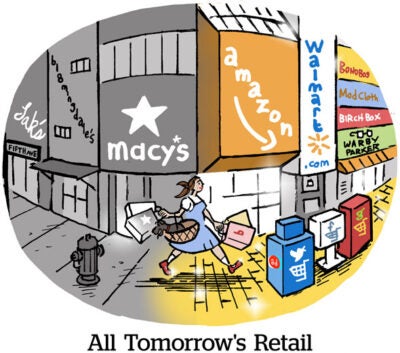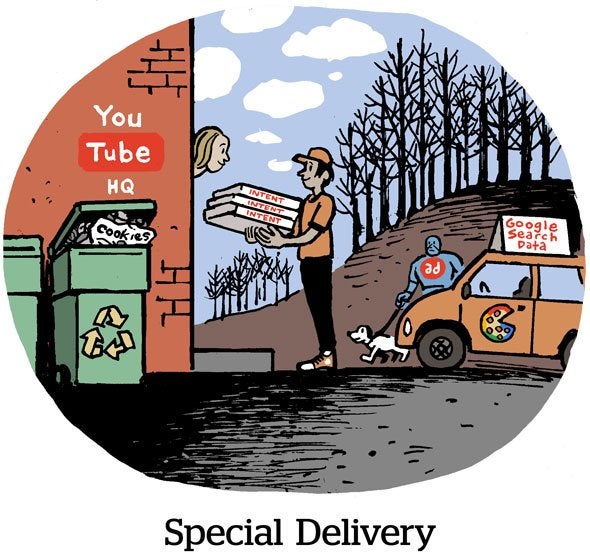Hey! This is James Hercher, AdExchanger’s senior editor and commerce industry beat reporter. Welcome to the inaugural dispatch of AdExchanger’s Commerce Newsletter.
In this weekly series, we’ll cover an expanse of retail and ecommerce. We’ll explore the convergence of offline and online, as digital brands enter store shelves and traditional CPGs figure out how to make the web work. We’ll dive into fulfillment and supply-chain data.
We’ll examine retail media walled gardens and the actual inventory behind their walls.
Don’t forget to smash “Subscribe” and forward to all of your commerce-curious friends. You may as well sign them up now and you can thank me later.
So, let’s kick this thing off with a peek behind the curtain at Google’s Performance Max.
Take it to the Max
In mid-December, I referred to Performance Max, the retail and shopper marketing product that’s eating up ad budgets and the web, as Google’s “blackest black box.”
It’s a great line and I stand by it. PMax advertisers receive less campaign data than ever before and have fewer controls to advertise across Google media. For many retail and ecommerce brands, PMax is already on par with YouTube or Google Search as a must-have line item.
However, PMax hasn’t won over marketers the way YouTube and Google Search have over years of experience. And the lack of controls push advertisers to the brink of what they’ll accept from a walled garden, even Google.
But Google is delivering on advertiser feedback, and some agency and ecommerce partners are optimistic Google will make concessions to them – a major temperature change since last year.
In a recent round of product road map briefings with close advertising partners, Google revealed plans for incremental updates to PMax, according to three different advertisers who spoke with AdExchanger but couldn’t share other specifics because they’re under NDA.
Befitting a black box, however, even Google’s updates to PMax are strange and obfuscated.
For instance, two weeks ago, Google formally rolled out a new tool so advertisers can use negative search keywords for PMax campaigns. The tool allows buyers to avoid certain terms, so a vegan food brand, say, doesn’t show up against animal protein searches, even if Google’s algo says the ROAS is there.
For many, this update wasn’t a surprise. For months, negative keyword controls were rolled out in batches to PMax accounts, to sometimes later disappear, or be available on one campaign and not another. Other accounts never saw them until the full rollout.
But even when Google adds PMax features, it must strike a balance between transparency and a black box model.
For instance, while Google was testing negative search keywords, advertisers hoped the update might be an elegant way to test PMax campaigns. By withholding some terms for their own non-PMax campaigns, buyers can compare PMax search to in-house search and attribute outside the black box.
Google parried by placing negative keyword controls at the account level, meaning that to block a keyword on PMax, advertisers must also block it everywhere. The upshot? Keywords can’t be used as control groups for PMax testing.
Here’s a scoop, though: Google will begin working on additional PMax controls for campaign-level brand exclusions as part of an announcement slated for next week, a Google exec told me. That change will add the flexibility to block PMax from buying branded search terms (“Levi’s jeans,” “nearby McDonald’s,” “MGM Grand,” you get the picture) while the advertiser continues bidding on brand keywords for their own search campaigns.
A new generation of creative
Still, advertisers have a few more requests. And there are more features Google is apparently tinkering with in the background, just like negative search controls last year.
One of the most irksome things about PMax is that Google autogenerates creative to serve across YouTube, Gmail, Maps and product listings, et al., even if a marketer didn’t upload creative for those channels.
Advertisers that don’t want to advertise in YouTube Shorts, for instance, might only upload longer, landscape-mode videos. But too bad! Google will use those videos to autogenerate Shorts and serve ads there anyway.
Often, advertisers only find out that Google autogenerated creative when they spot new ads they didn’t create in the wild, since these placements aren’t reported by PMax.
 But Google seems to be working on an option to disable at least some autogenerated creative, according to two advertisers who have seen the toggles appear in UIs and spoke with AdExchanger.
But Google seems to be working on an option to disable at least some autogenerated creative, according to two advertisers who have seen the toggles appear in UIs and spoke with AdExchanger.
My sources tell me this semi-mythical toggle to disable autogenerated creative has appeared intermittently for certain accounts and it’s not clear the tool is functional, even when it does appear.
Google tells me, though, it is planning to introduce controls for some autogenerated content, specifically, text and images. (You’ll still get YouTube Shorts, though, so deal with it).
In other toggle news, two additional toggles sighted lately in the PMax UI would disable the Google Display Network (GDN) and Google Search partner network buys. But those toggles showed up grayed out in the UI, so advertisers can only look forward to them being real options one day.
And, as yet another sign of how hard it can be to distinguish real product updates from bugs, the Googler who spoke with me on background said the PMax toggles to disable GDN and the Google Search partner network are the result of Google Ads Editor displaying options that aren’t actually available in the PMax system. Even when an opt-out option to disable the display network is available, it won’t be honored by PMax.
Sometimes a toggle toggles its way into reality, a sign of how tinkering can pay off. But other toggles are just a mirage.
What’s next?
With these product changes, Google has identified many of the biggest issues vexing advertisers about PMax – including the need for better search controls.
Some businesses spend hundreds of thousands of dollars – if not millions – to test search retargeting and branded search campaigns so they can avoid potentially paying tens of millions over time.
For instance, some marketers avoid retargeting someone who started a cart or is searching for their brand name, because they feel it’s likely an organic conversion. These marketers won’t stomach Google using those tactics to claim easy conversions.
Aside from search controls, PMax’s other weak point is GDN. The display network is the monetization system of the open web – aka the long tail – and it includes a lot of hot garbage.
If Google can deliver on the “performance” part of PMax while returning some control over search and the ability to block GDN, PMax could remain the blackest black box, and yet advertisers will still call it a win.



















